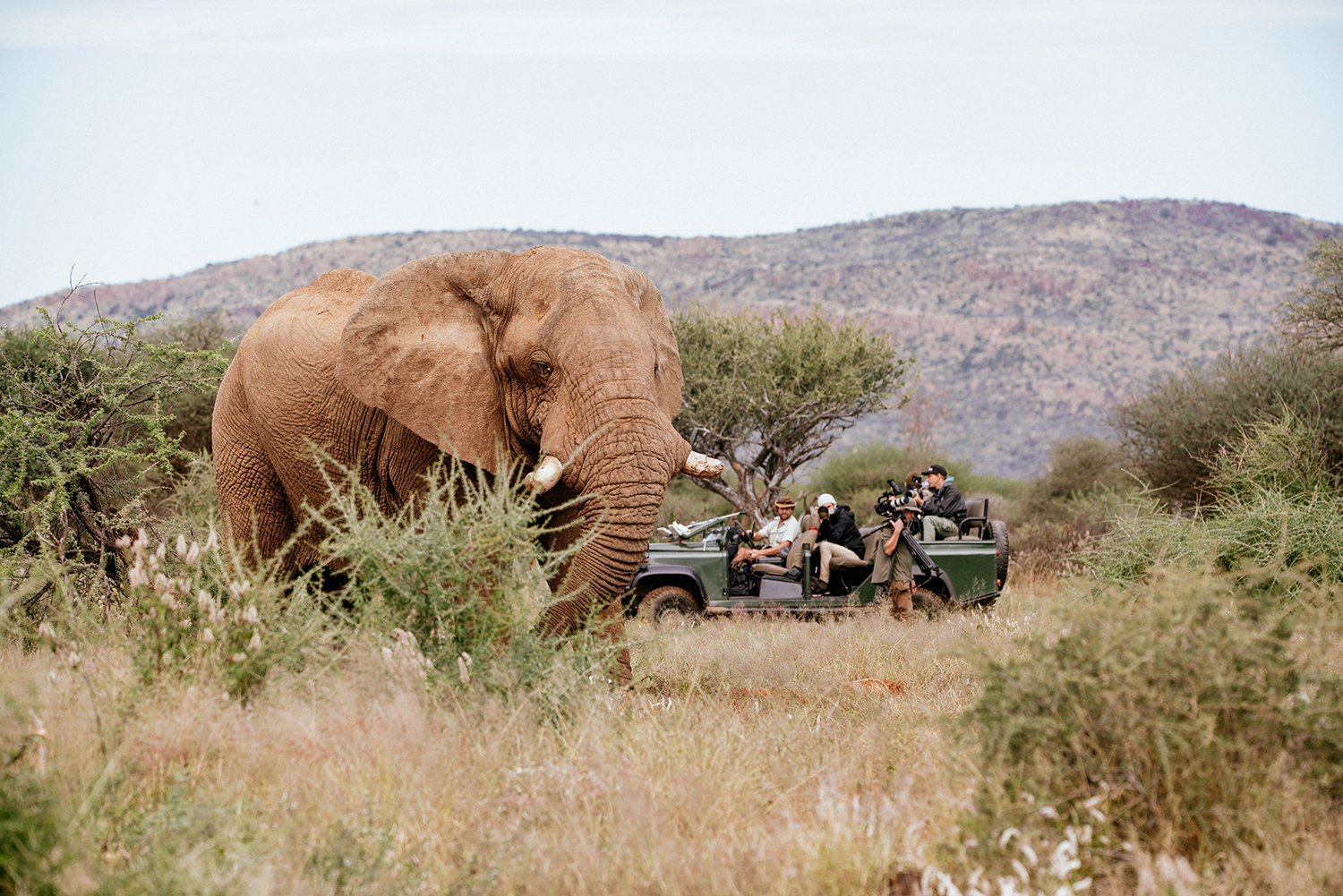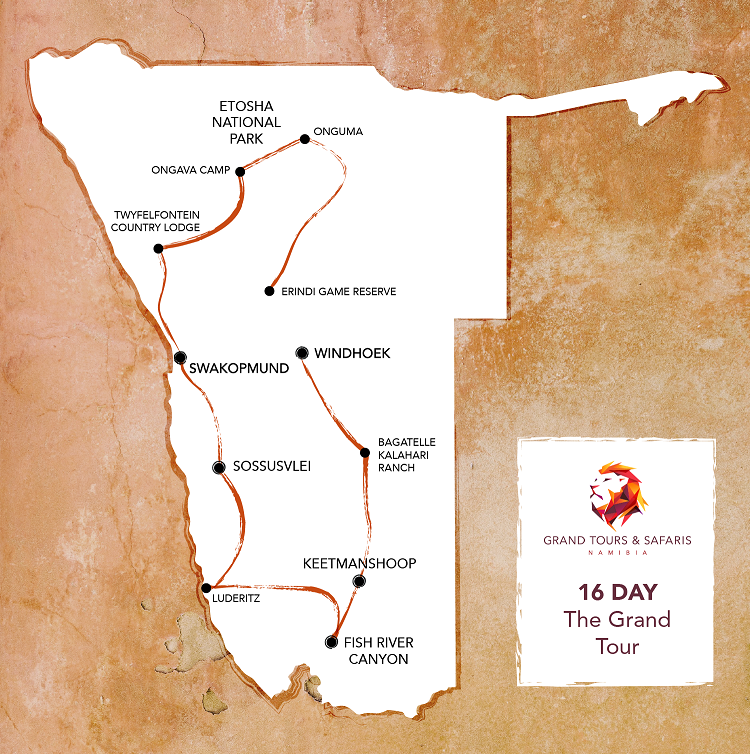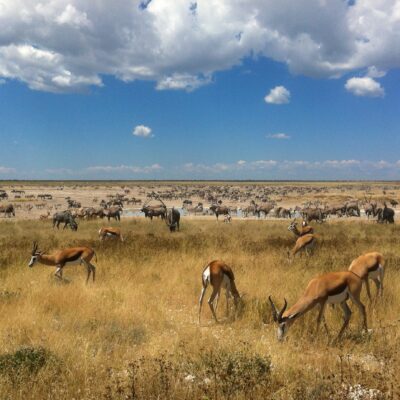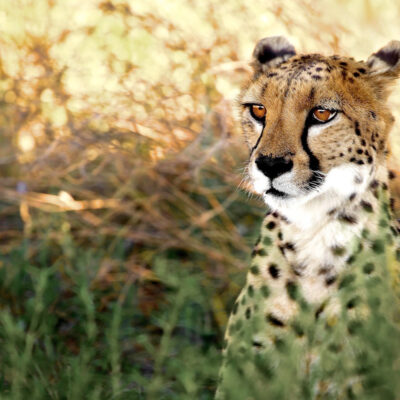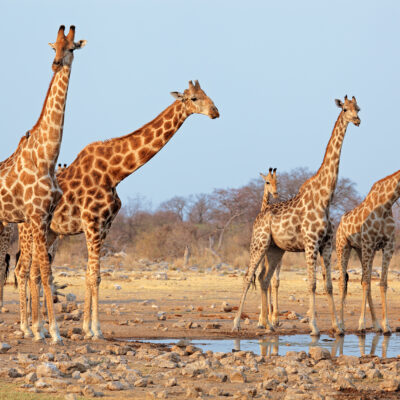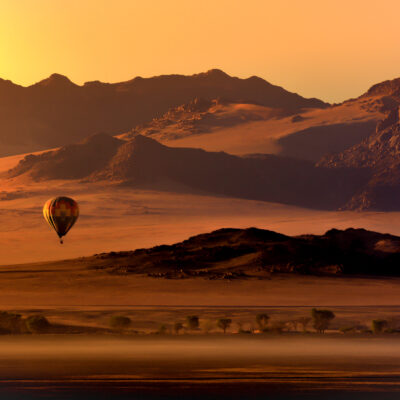Description
The name says it all. This tour covers the whole of Namibia. From the wide-open spaces in the south, to the crimson dunes of the Kalahari. From abundance of wildlife in the north, to the oldest desert in the world in the east.
Day 1 Windhoek
Day 2 Kalahari
Day 3 Fish River Canyon
Day 4 Fish River Canyon
Day 5 Luderitz
Day 6 Luderitz/ Aus
Day 7 Sossusvlei
Day 8 Sossusvlei
Day 9 Swakopmund
Day 10 Swakopmund
Day 11 Twyfelfontein
Day 12 Etosha West
Day 13 Etosha East
Day 14 Etosha East
Day 15 Erindi
Day 16 Depart
Day 1
After the plane has touched down at Hosea Kutako International Airport and you have collected your 4×4 vehicle, a short drive will lead you to Windhoek. Windhoek is the capital of Namibia and will give you a glimpse into colonial history through its architecture intertwined with the modern. Experience the warm hospitality, cuisine and culture that will leave a lasting impression. In the city centre, you can visit the historic Christuskirche, Zoo Park, and Tintenpalast. Stock up on Namibian gifts and souvenirs at the Craft Centre.
Day 2
With its dramatic and timeless scenery, the Kalahari will enchant you with its unspoiled, desolate landscapes dotted with silhouettes of camel-thorn trees on crimson sand dunes. Silence and tranquil solitude will infiltrate your soul as you immerse yourself in its magical charm. A variety of fauna and flora call the Kalahari home, which means you will never have a dull moment checking off animals from your list: meerkat, jackal, gemsbok and many different antelope species. The most fortunate of travellers could also encounter predators, like the cheetah.
Day 3/4
The gigantic Fish River Canyon – the largest canyon in Africa – takes an honoured second place after the Grand Canyon in the USA. Many travellers, especially avid hikers, are attracted by the alluring scenery of enormous proportions that never fails to amaze. Merely standing in front of the canyon and experiencing a sunset will leave you speechless. Snap-happy fingers cannot get enough of trying to capture this geological masterpiece. Although nothing can come close to seeing it for yourself.
Day 5
Charming Lüderitz finds itself wedged between the southern Atlantic coastline and the barren Namib Desert. Its unique geological setting makes it the town that was principally built on a rock – the only rocky part of the Namibian coastline. This time capsule of a town, rich in history, boasts German art nouveau architecture, which makes it seem as if it comes straight out of a story book. It is one of the first places in Namibia where colonisers had set foot. After the discovery of diamonds, German forces colonised the town. Its geographically challenged neighbour, the fascinating ghost town of Kolmanskop, a former diamond town, had a different fate. What seemed to be infinite treasure had soon been worn out and there was no diamond left to spare. The town was abandoned and is now gradually being swallowed by the sands of time. Of course, avid photographers will have to clear up space on SD cards to avoid any disappointment of not being able to capture the photo-worthy scenery. A trip to this part of the world is a thought-provoking reminder of times gone by.
Day 6/7/8
En route: Aus to Sossusvlei
The road loops north to north-west, winding between the mountains and the dunes of the Namib – which is also a ticket to one of the world’s greatest shows. Herds of gemsbok, springbok and occasional ostrich will provide entertainment on nature’s stage with black, rocky mountains and dark orange dunes providing the incredible backdrop. Aus is the welcome half-way stop en route to Sossusvlei. The tiny town borders the Tsau //Khaeb Sperrgebiet, the forbidden diamond mining area. In days gone by, this is where miners, ravenous for riches, gathered in the perpetual search for diamonds and dreams. This area now offers travellers the chance to witness the wild horses galloping across the endless vistas, every stride creating a cloud of golden dust in the Namib.
Sossusvlei tops all avid travellers’ bucket-lists, and with good reason. No visitor leaves the sight of the burnt orange sand dunes without awestruck gratification. As soon as you start climbing Dune 45 or Big Daddy, you realise you just signed up for what might be the most rewarding leg work out yet. Standing atop the dune with the velvety sand tickling your toes, you start thinking that it cannot get any better. But it does – the orange swirls of sand lead you into a valley called Dead Vlei – the postcard-perfect scenery a geological marvel. Early mornings and late afternoons make for flawless photographic shots.
The fun is not yet over. Hike the astonishing Sesriem Canyon. As the sedimentary rock trail leads you one kilometre into geological history, you realise that, at one point in time, millions and millions of years ago, the Tsauchab River was the artist of these wall carvings that stretch up to 30 metres above your head.
Day 9/10
En Route
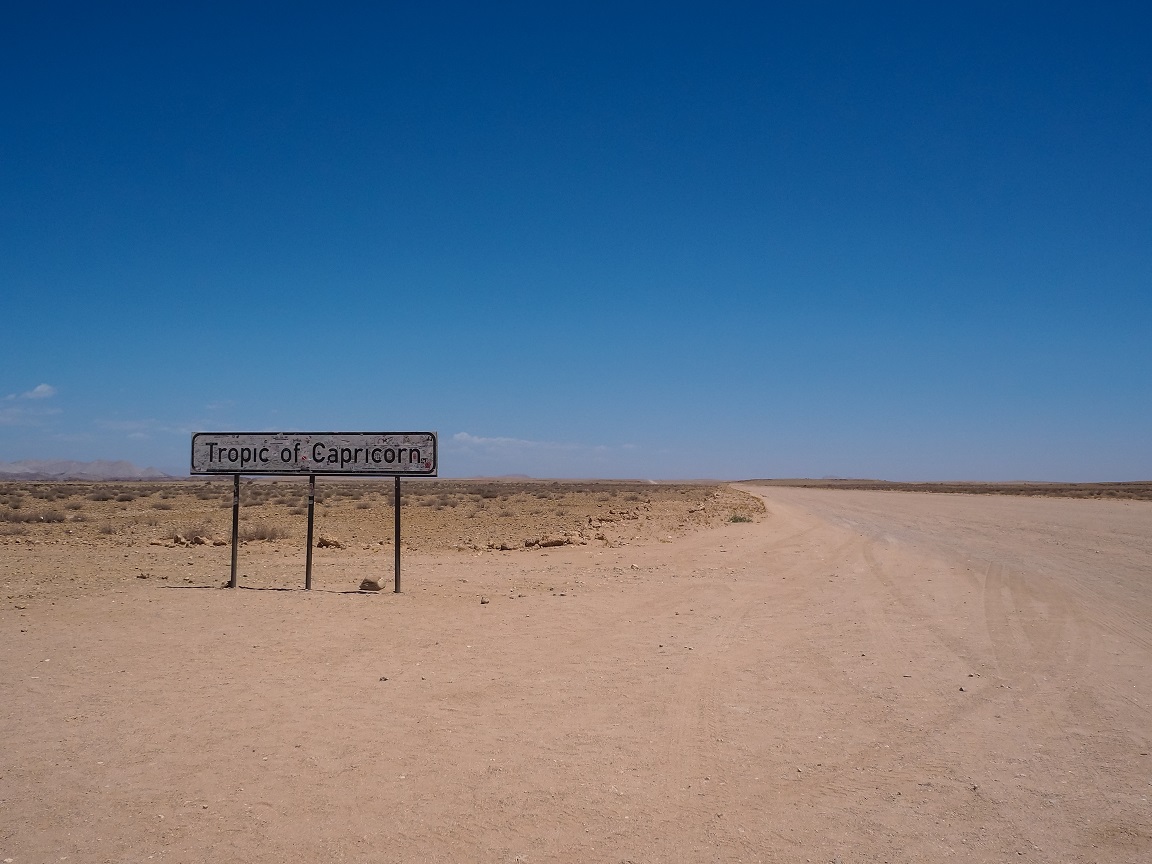
As you tear yourself away from the magnificence of Sossusvlei, you start following a one-of-a-kind road that meanders through the Namib Desert. Along the road, you will come across Solitaire, a remote historical settlement surrounded by gravel plains – a highlight for many travellers who stop here for coffee. Another highlight is capturing photos of the “Tropic of Capricorn” road signs adorned with a multitude of colourful stickers, indicating that you have now traversed the southernmost latitude. The winding road towards Swakopmund swerve in and out of the Namib-Naukluft National Park, one of the largest conservation areas in Africa, which covers a larger surface per square kilometre than Switzerland.
As a main witness of German colonial Africa and therefore resonating its lingering taste, Swakopmund lies between the embrace of the mighty Atlantic Ocean and the rolling dunes of the Namib Desert. This spectacular seaside-town holds an old-world charm that can be best enjoyed while relaxing in the various cafés to choose from, sampling appetising local cuisine with an international flavour in a cornucopia of excellent restaurants or witnessing scintillating sunsets on the ocean while sipping sundowners on the dunes. Labelled as Namibia’s activity hub, Swakopmund also offers heart-racing activities and family adventures, as well as day excursions to the desert. This colourful coastal town acts as the gateway to the otherworldly Skeleton Coast, best known for the shipwrecks it has claimed.
Day 11
Twyfelfontein in Damaraland generally needs little to no introduction in tourism circles. This historic site bursts with interesting stories of the past. As an open-air museum, it contains an array of rock engravings and paintings, giving an interesting glimpse into the lives of the first people who moved through or inhabited the region. UNESCO has recognised the immensity of this incredible site, and therefore declared it a World Heritage Site. You can further immerse yourself into the region with a visit to geologically interesting sites, such as the Organ Pipes and Burnt Mountain. Or join in the dancing and singing as you learn more about the local culture at the Damara Living Museum.
Day 12/13/14
Namibia’s beloved flagship game park, Etosha National Park, extends over 22,912 km2. The park was thus named after the salt pan covering 5000 km2 that is visible all the way from space. Etosha, meaning “great white place”, once saw a river flowing past here over 2 million years ago called the Kunene Delta. But the river has changed its course many moons ago, leaving behind the salt pan that has gained world fame. Today, over 100 mammal species and 340 bird species call this place home, oll of which can be spotted on safari and the floodlit waterholes. Accommodation in Etosha caters to all adventurer types ranging from its popular, comfortable campsites and mid-market chalets to upmarket options boasting creature comforts. Etosha is akin to a little village with an airfield, gas stations, pools, restaurants, shops and more.
Day 15
An absolute must at the top of any safari destination list is Erindi Private Game Reserve. A visit to Erindi will bring your wildest safari expectations to life. Erindi means “place of water” in the Herero language. Its sprawling 70,719 hectares located just southeast of Omaruru in the central plateau of the country is a safari dream come true. Aside from unlimited wildlife sighting opportunities, Erindi hosts over 20 exciting activities. Numerous conservation projects have come to life here, including projects on the aardvark, the cheetah and the elephant. While Erindi boasts prolific numbers of endemic and indigenous wildlife species, the reserve is also an avid birdwatchers’ paradise with over 300 bird species. There are three different accommodation types ranging from all-inclusive suites to self-catering chalets, all of which imbue comfort in the bush.
Day 16 Depart for Windhoek

